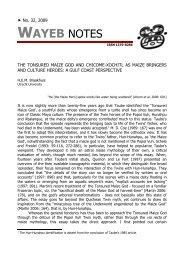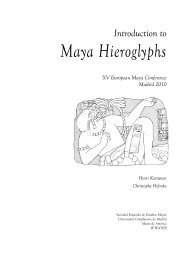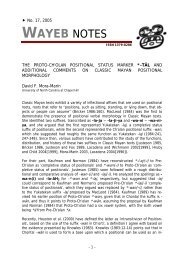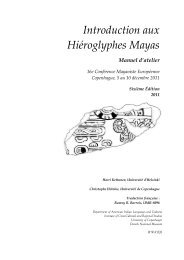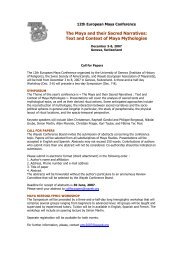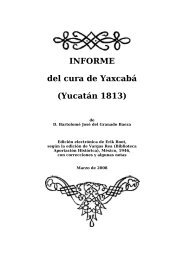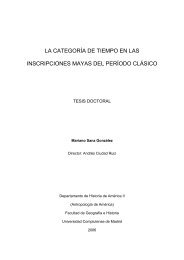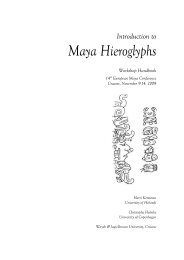Introduction to Maya Hieroglyphs - Wayeb
Introduction to Maya Hieroglyphs - Wayeb
Introduction to Maya Hieroglyphs - Wayeb
You also want an ePaper? Increase the reach of your titles
YUMPU automatically turns print PDFs into web optimized ePapers that Google loves.
Kettunen & Helmke 2011<br />
The Writing System<br />
The following is <strong>to</strong> serve as an example how the above indicatedd stages function:<br />
1. a-wo-la<br />
2. awo[h]l<br />
3. aw-ohl<br />
4. 2SE-heart<br />
5. “your heart”<br />
1. chu-ka-ja<br />
2. chu[h]kaj<br />
3. chu[h]k-aj-Ø<br />
4. capture[PAS] ]-THM-3SA<br />
5. “he/she was captured”<br />
1 = transliteration<br />
2 = transcription (& phonological reconstruction)<br />
3 = morphological segmentation<br />
4 = morphological / morpho-syntactic analysis 29<br />
5 = translation<br />
When translating <strong>Maya</strong> texts one should keep in<br />
mind that there are various ways of nterpreting given words<br />
and sentences. Quite often one finds<br />
rather rigid translations (or more precisely glosses/ glossing) of given texts<br />
where the sentences are translated (or glossed) word-<strong>to</strong>-word. One should keep in mind<br />
that this is not a real<br />
translation per se but rather a method<br />
<strong>to</strong> show how<br />
the sentencee is structured<br />
in the original language as opposed<br />
<strong>to</strong> the (target) language<br />
in<strong>to</strong> which the sentence is translated.<br />
The actual translation can also be divided in<strong>to</strong> different stagess and versions where one can move from<br />
rigid <strong>to</strong><br />
less strictt translations. The actual meaning of a word or a clause might be different in another language, but the<br />
original concept should<br />
be preserved<br />
at least in one of the stages of translating the text. In the example on page 17<br />
the expression “his/her (?) white wind/breath got withered” serves as a metaphor or as a euphemism for the<br />
targeted meaning of “he/she died.” However, such a ‘loose translation’ can<br />
only be achieved by understanding<br />
the culturally-specific idiom which is used, thereby eliminating the subtletiess of the original expression.<br />
As regards translating <strong>Maya</strong> names and titles, we are leaning <strong>to</strong>wards the routine of not translating them<br />
at all, or<br />
translating only well-attested titles. This approach<br />
is based on the fact that the concepts which these embody are<br />
not easily<br />
translated by a single word in English (as volumes may be written on each<br />
concept <strong>to</strong> clarify the<br />
specific meaning of each title).<br />
Modus operandi 30 :<br />
1. Select a text<br />
2. Transliterate the text<br />
a. Do not mark reconstructed sounds<br />
b. Use lowercase bold for syllabic<br />
signs<br />
c. Use UPPERCASE BOLD for logograms<br />
3. Transcribe the text<br />
a. use italics<br />
b. all reconstructed<br />
sounds (except for those based on orthography rules should<br />
be represented<br />
in [square brackets]<br />
4. Analyze the text<br />
a. divide morphemes by hyphens<br />
b. mark grammatical elements<br />
5. Translate the text using different stages of translation<br />
Finally one should go back <strong>to</strong> the original (hieroglyphic) text, and through these steps, understand it. Eventually<br />
you should reach the point where you go back <strong>to</strong><br />
the original text, and understand it without the restrictions of<br />
your innate grammar.<br />
29<br />
PASsive voice, THeMatic suffix, 3rd person Singular Absolutive pronoun. See also Glossary of Linguistic Terminology.<br />
30<br />
During the <strong>Maya</strong> hieroglyphic workshops it is not sensible or even possible <strong>to</strong> go through with all the stages listed here. More commonly, a<br />
strategy of structural analysis is employed along<br />
with basic transliterations, transcriptions and translations.<br />
15/154



